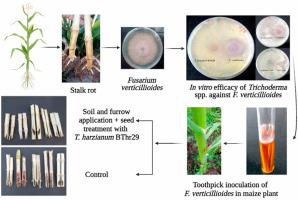Crop Protection ( IF 2.8 ) Pub Date : 2021-10-06 , DOI: 10.1016/j.cropro.2021.105838 Prashant P. Jambhulkar 1, 2 , M. Raja 3 , Bhumica Singh 1 , Sonali Katoch 1 , Shailendra Kumar 2 , Pratibha Sharma 3

|
Fusarium spp. complex, (Fusarium verticillioides, F. subglutinans, F. moniliforme, F. graminearum) causing post flowering stalk rot (PFSR), has been reported as a serious disease in southern Rajasthan, and eastern Gujarat in winter maize. In the present study, emphasis has been laid on the efficacy of twenty seven Trichoderma strains against F. verticillioides which is a major causal organism. Efficacy evaluation of Trichoderma strains was based on the radial growth of the pathogen in the presence of biological control agent (BCA). Based on per cent inhibition three potential native strains of Trichoderma spp (Trichoderma harzianum BThr29, T. asperellum BTas25, and T. erinaceum BTer43) were selected for biological control of PFSR in the field. T. harzianum BThr29, T. asperellum BTas25, and T. erinaceum BTer43 showed per cent inhibition of F. verticillioides by 87.8, 83.9, and 81.1 percent respectively. Maize plants were artificially inoculated with F. verticillioides, and three potential Trichoderma strains were delivered as soil application (Trichoderma enriched FYM 10 tones ha−1), seed treatment (10 g/kg seeds), and drenching (10 g/liter water). Split stem observation at the harvest of crop showed a restricted lesion of T. harzianum BThr29 treated plant at par with fungicidal application with an average mean rating scale of 1–1.3, which showed less than 50% discoloration in inoculated internode. In control, the mean disease rating scale was 3–3.4 which showed 51–75% of the inoculated internode is discolored. Application of Trichoderma strains improved crop stand by reducing lodging from 42.1 to 71.1% in inoculated maize plants, and reduced PFSR disease severity from 17.58 to 62.37%, Fungicidal application reduced lodging of maize plant from 57.91 to 77.78% and PFSR disease by 58.24–64.35% as compared to untreated control. The results obtained suggested that Trichoderma harzianum BThr29 has the potential to be used as a non-chemical alternative for PFSR disease management in maize crops.
中文翻译:

潜在的天然木霉菌株对抗轮枝镰刀菌导致冬玉米花后茎腐病
镰刀菌属 据报道,在拉贾斯坦邦南部和古吉拉特邦东部的冬玉米中,引起花后茎腐病 (PFSR) 的复杂菌( Fusarium verticillioides、F. subglutinans、F. moniliforme、F. graminearum ) 是一种严重的病害。在本研究中,重点放在了 27 种木霉菌株对轮枝镰刀菌(一种主要的致病微生物)的功效上。木霉属菌株的功效评估基于病原体在生物控制剂 (BCA) 存在下的径向生长。基于抑制百分比,三种潜在的木霉属天然菌株( Trichoderma harzianum BThr29, T. asperellumBTas25 和T. erinaceum BTer43) 被选择用于野外 PFSR 的生物控制。T. harzianum BThr29、T. asperellum BTas25 和T. erinaceum BTer43 对轮枝杆菌的抑制率分别为 87.8%、83.9% 和 81.1%。将玉米植株人工接种轮枝杆菌,并将三种潜在的木霉菌株作为土壤施用(富含木霉的FYM 10 吨 ha -1)、种子处理(10 g/kg 种子)和浸透(10 g/升水) . 作物收获时的裂茎观察显示哈茨木霉病灶有限BThr29 处理的植物与杀菌剂应用相当,平均等级为 1-1.3,表明接种的节间变色小于 50%。在对照中,平均疾病等级为 3-3.4,显示 51-75% 的接种节间变色。木霉属菌株的应用通过将接种的玉米植物的倒伏从 42.1% 减少到 71.1%,并将 PFSR 病害严重程度从 17.58% 降低到 62.37%,改善了作物抗旱性,杀真菌剂的应用将玉米植物的倒伏从 57.91% 减少到 77.78% 和 .56.78% 的 PFSR234– 疾病% 与未处理的对照相比。获得的结果表明,哈茨木霉BThr29 有可能用作玉米作物 PFSR 病害管理的非化学替代品。



























 京公网安备 11010802027423号
京公网安备 11010802027423号